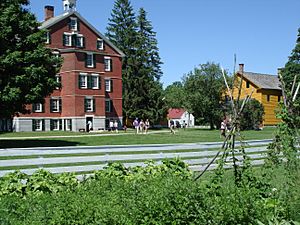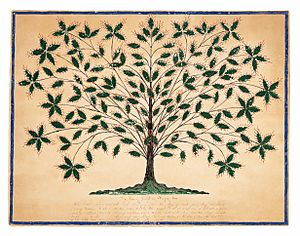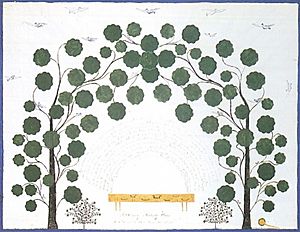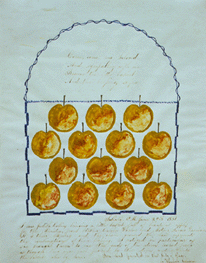Hannah Cohoon facts for kids
Quick facts for kids
Hannah Cohoon
|
|
|---|---|
| Born |
Hannah Harrison
February 1, 1788 |
| Died | January 7, 1864 (aged 75) |
| Nationality | American |
| Known for | Painting |
|
Notable work
|
The Tree of Life |
| Movement | Shaker |

Hannah Cohoon (born February 1, 1788 – died January 7, 1864) was an American artist. She was born in Williamstown, Massachusetts. Hannah became a member of the Hancock Shaker Village when she was 29 years old.
During a special time called the Era of Manifestations, she created unique "gift drawings." These drawings were inspired by her religious beliefs. Her art is now famous and helps us understand the Shaker way of life. She passed away in 1864 and was buried in the Hancock Church Family cemetery.
About Hannah Cohoon's Life
Hannah Cohoon was a member of the Hancock Shaker Village. She made "gift drawings" that shared spiritual messages. These messages came from visions she had during the Era of Manifestations. This was a time when Shakers experienced many spiritual events.
Hannah was special because she signed her drawings. Most Shaker artists did not sign their work. Her art style was very unique. It was more abstract, simple, and personal. She also used a painting method called impasto. This made her drawings have a thick, textured feel.
Hannah's Early Years
Hannah Harrison was born on February 1, 1788. She was one of three girls. Her parents were Noah B. Harrison and Huldah Bacon Harrison. Her father, Noah, was a drummer boy in the American Revolutionary War. He died when Hannah was just one year old.
Hannah had two older sisters, Lois and Polly. Hannah later had a son named Harrison and a daughter named Mariah.
She joined the Hancock Shaker community on March 15, 1817. She was 29 years old at the time. Her son Harrison was 5, and her daughter Mariah was 3. She signed the Shaker agreement, called a covenant, in 1823. Later, in 1843, she signed the Sacred Roll. Her last name, Cohoon, is what she used for her artwork.
Hannah Cohoon's Artwork
The Era of Manifestations
Between 1837 and the 1850s, the Shaker community experienced a big spiritual change. This time was called the Era of Manifestations. During this period, many Shaker "believers" had spiritual visions. They shared these visions through songs, dances, and drawings. People who received these visions were called "instruments."
Shaker founders and early leaders had often preached about heavenly treasures greatly to be desired. Never before, however, had Shakers dared to picture these heavenly treasures. Never before had Believers seen with their eyes the close formal resemblance between the things of eternity and the things of time. The subject matter and form of the instruments' images had been prohibited for many years as a threat to the purity of the sect. But a celestial content tempered and made useful this potentially radical art.
– Spiritual Spectacles: Vision and Image in Mid-Nineteenth-Century Shakerism.
These deep spiritual experiences led Shakers to create "gift drawings." These drawings showed the "gifts" they received from the Spirit. About 200 gift drawings still exist today. Most were made by women living in Hancock Shaker Village, Massachusetts, or Lebanon, New York.
One example is Gift Drawing: A Reward of True Faithfulness from Mother Lucy to Eleanor Potter. This was made by Polly Ann (Jane) Reed. These "gift drawings" were based on amazing messages from spiritual visits. Artists made them with great care, often using watercolors or transparent inks.
The drawings often included many small symbols. These were considered very fancy for Shaker art. They showed things like treasure chests, heavenly homes, golden chariots, flowers, and fruits. They also had written messages of friendship or respect. These messages were written in a beautiful, fancy style. Usually, the artists did not sign these works.
Important Shaker artists from this time included Hannah Cohoon, Polly Collins, and Joseph Wicker. The Era of Manifestations ended when some Shaker members felt embarrassed by the strong emotions and mystical expressions of this period.
Famous Works by Hannah Cohoon
Hannah Cohoon started making her drawings in 1845. She had a unique style compared to other Shaker artists. She used thick paint in bright primary or secondary colors. This created an impasto texture with bold brushstrokes. Her paintings often focused on one object or scene with geometric patterns.
Instead of writing messages for others, she wrote directly about her own visions. And, as mentioned, she signed her artwork.
Cohoon is most famous for her spirit drawings of trees:
- The Tree of Life or Blazing Tree, 1845
- The Tree of Life, 1854
- A Bower of Mulberry Trees, 1854
A Bower of Mulberry Trees was inspired by Cohoon's vision. She saw Shaker elders having a feast of cakes under mulberry trees. The long table in the drawing shows holy feasts held at special meetings. The doves flying overhead represent the blessings a believer would find in heaven.
Joseph Wicker, an elder in the Shaker community, also created a gift drawing of a tree in 1844. This might have inspired Hannah's tree paintings.
Cohoon explained how she got the idea for her Tree of Life drawing:
I received a draft of a beautiful Tree pencil'd on large sheet of plain white paper bearing ripe fruit. I saw it plainly, it looked very singular and curious to me. I have since learned that this Tree grows in the Spirit Land. Afterwards the Spirit showed me plainly the branches, leaves and fruit, painted or drawn upon paper. The leaves were check'd or cross'd and the same colours you see here. I entreated Mother Ann to tell me the name of this tree which she did on Oct. 1st 4th hour P.M. by moving the hand of a medium to write twice over Your Tree is the Tree of Life.
The Tree of Life has become a symbol for the Shakers. In 1996, another painting by Cohoon, similar to Tree of Light or Blazing Tree, was expected to sell for a very high price. It sold for $299,500 to the Museum of American Folk Art in 1997.
She also made A Little Basket Full of Beautiful Apples in 1856. A writer named Adam Gopnik described this drawing as "among the key drawings in American art." He noted its feeling of "abundance" with all the apples looking similar, like blush applied by a teenager.
Cohoon is best known for her gift drawings, especially The Tree of Life. While famous for her paintings, she also composed music.
Death and Lasting Impact
Hannah Harrison Cohoon died in Hancock, Massachusetts on January 7, 1864. She is buried in the Church family cemetery.
In 1931, Sister Alice Smith of Hancock Shaker Village shared four of Cohoon's gift drawings with Shaker historians Faith and Edward Deming Andrews. The Andrews then organized an art show at the Whitney Museum of American Art in 1935.
An image of Cohoon's Tree of Life appeared in a magazine article in 1945. The Andrews also used the image for the covers of their books in 1969 and 1975. The Hancock Shaker Village became a museum in 1960. Later, the Andrews sold Cohoon's drawings and other gift drawings to the museum.
In 1974, her Tree of Life drawing was used on a UNICEF Christmas postcard. This helped raise money for the organization. The Whitney Museum displayed four of Cohoon's drawings in a 1980 art show. Her works were also shown in an exhibit in New York in 1983.
Gerard C. Wertkin, the director of the American Folk Art Museum in New York City, said that Cohoon is "considered the pre-eminent Shaker artist." He added that her works "have become icons of Shaker material culture." This means her art is a very important part of Shaker history and culture.






